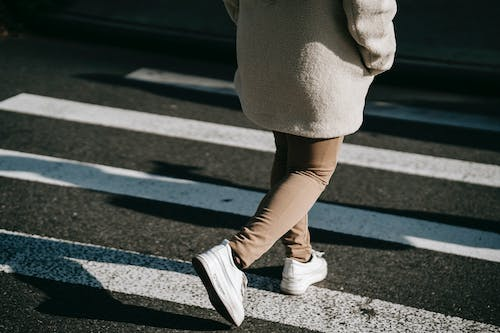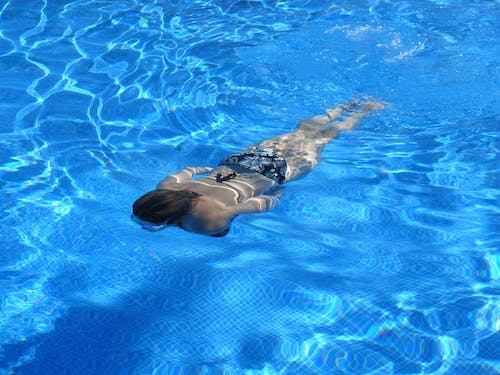When it's that time of the month again, you might find yourself wrapped up in a blanket, using a heating pad to combat period cramps. And it's completely understandable if you prefer to stay still and cozy. However, if you're open to a bit of physical activity, rest assured that there are numerous gentle and low-impact options available. In fact, some of them may even provide the period pain relief you're looking for.
Undoubtedly, period cramps can make it challenging to engage in physical activity, acknowledges Sasha Mihovilovic, a master trainer at AKT workout studio. However, she emphasizes that exercise actually helps improve circulation, which can alleviate muscle soreness. Alayna Curry, an AFAA-certified fitness trainer, adds that even a little movement can boost your mood and facilitate better sleep—both of which are a blessing when you're experiencing discomfort.
If you've been struggling with PMS symptoms and find yourself lying awake, a gentle yoga session or a leisurely walk might be just what you need. During your period, it's important to focus on stretches and gentle workouts. Opting for low-impact and moderate-intensity exercises is generally recommended. This isn't the moment to push yourself with intense HIIT classes or heavy weightlifting. So, why not slide off the couch and give these moves a go?
Key Takeaways
- Boost Circulation & Mood: Gentle exercises for menstrual cramps improve blood flow to alleviate muscle soreness and trigger the release of endorphins, your body's natural painkillers and mood elevators.
- Focus on Low-Impact Movement: Activities like walking, swimming, and gentle yoga are ideal. It's best to avoid high-intensity workouts that could increase discomfort during your period.
- Targeted Stretches Provide Relief: Poses like Child's Pose, Cat-Cow, and Supine Twists specifically target the lower back and abdomen to release tension where cramps are most felt.
- Listen to Your Body: The primary goal is comfort and relief. It's crucial to choose activities you enjoy and to adjust intensity based on how you feel each day.
1. Glute Bridges
Here's a recommended exercise from trainer Alayna Curry to stretch and strengthen your lower back muscles, which can become tense and cramped during your period:
- Start by lying on your back with your knees bent and feet flat on the floor.
- Gradually lift your hips off the ground, raising your buttocks towards the sky.
- Hold this position for a second.
- Slowly lower your hips back down.
- Repeat this sequence for a total of 4 sets, with 12 repetitions in each set.
2. A Leisurely Walk
Taking a leisurely 20 to 30-minute walk can be an effective method to alleviate bloating and pain. According to Dr. Kristina Kehoe, PT, DPT, a board-certified specialist in women's health, going for a walk at a comfortable pace can not only improve blood circulation but also trigger the release of endorphins, which are known as "feel-good" hormones. Put on a pair of sneakers and set aside some time for your walk. This simple activity can make a real difference.
3. Downward Dog
Dr. Kehoe also suggests incorporating this popular yoga pose into your routine. "This exercise focuses on stretching the posterior chain, which can feel tight during menstruation," she explains. You don't need to change into leggings for this one—your sweatpants will work just fine.
- Begin on your hands and knees, in a tabletop position.
- Lift your hips upward, pressing them towards the sky.
- Lower your heels as far as you comfortably can.
- Relax your head and neck, allowing them to hang freely.
- Hold this pose for 3 to 5 deep breaths.
4. Supine Twist
If you're experiencing PMS symptoms and prefer to stay in bed, this gentle stretch can provide relief for your abdomen and back. Dr. Kristina Kehoe recommends this relaxing exercise:
- Lie on your back with your knees bent and feet resting on the bed.
- Slowly lower both knees to one side.
- Allow your head to turn in the opposite direction.
- Hold this position for 3 to 5 counts.
- Repeat the movement 3 to 5 times on each side.
Take your time with this stretch and stay in the position for as long as necessary to experience the desired comfort.
5. Elliptical Machine
Soji James, a certified personal trainer, suggests incorporating a brief aerobic exercise session. According to credible research, increasing your heart rate also boosts endorphin levels, leading to an improved mood and natural period pain relief. One option is to hop on an elliptical machine and maintain a steady pace. It's important to avoid pushing yourself too hard if you're feeling lethargic. Listen to your body and adjust the intensity accordingly.
6. Fire Toes
Surprisingly, relieving tension in your feet can potentially help alleviate cramps. Sasha Mihovilovic explains that our feet often hold tension and stress, so taking a moment to release that can be beneficial.
- Sit in an upright position on your knees with your toes tucked under.
- Hold this pose for 30 to 60 seconds to stretch the ligaments and fascia in your feet.
- Shake out your feet and repeat the process 2 to 3 times.
7. Child’s Pose to Cobra
Mihovilovic suggests this combination of stretches to target your lower back, psoas, and abdominal wall:
- Begin by kneeling on the floor. Sit your hips back and extend your arms forward, entering into Child's Pose.
- Take 2 to 3 deep breaths in this position.
- Place your palms flat on the floor and transition into a Cobra Stretch by lifting your upper body while keeping your palms down.
- Take 2 to 3 deep breaths in the cobra stretch.
- Return to Child's Pose, allowing your arms to rest back at your sides. Stay here for 1 minute, breathing deeply.
8. Pelvic Tilts
Jake Dickson, a certified personal trainer, recommends this exercise to enhance blood circulation in the lower back:
- Lie on your back with feet slightly wider than hip-width apart.
- Gradually lift your hips off the floor, paying attention to each vertebra separately.
- Slowly lower back down.
- Repeat the motion of raising and lowering your hips for two minutes.
9. Cat-Cow
Michele Riechman, a personal trainer, suggests this straightforward yoga movement to alleviate tension. The cat-cow pose not only increases spinal mobility but also helps to calm the nervous system.
- Begin in a quadruped position (on hands and knees).
- Inhale deeply and drop your belly towards the floor while looking upward (Cow Pose).
- Exhale slowly, tucking your chin to your chest and rounding your spine (Cat Pose).
- Repeat this sequence 5 to 10 times, coordinating your breath with each movement.
10. Swimming
If you've been avoiding the pool during your period, now’s the time to wear the best period swimwear and dive in. Swimming is a gentle, low-impact exercise that can effectively alleviate cramps and bloating, according to Mary Sabat, an ACE-certified personal trainer. The natural buoyancy of the water relieves pressure on your joints and muscles, making exercise more comfortable. Enjoy the soothing benefits of swimming during your period.
11. Pilates 100
If you're looking for a gentle routine, consider trying a round of Pilates. You can find numerous 10-minute Pilates workouts on YouTube that suit your needs. Pilates is a low-impact exercise that combines strength training with stretching. A specific move you can start with is the classic "one hundreds" exercise.
- Lie on your back.
- Lift your legs and head off the ground.
- Bend your knees and reach for your toes.
- Engage your abdominal muscles and begin pumping your arms up and down.
- Inhale for five arm pumps and exhale for five pumps, continuing until you reach a count of 100.
Myth vs. Reality
Myth: You should avoid all exercise and rest completely during your period.
Reality: While listening to your body and resting when needed is vital, completely avoiding movement can sometimes worsen symptoms like cramping and bloating. As a former competitive athlete with a background in textile engineering, I can attest that the right kind of movement is beneficial. Gentle exercise improves circulation to the uterine muscles, helping to relieve cramps, while the release of endorphins acts as a natural painkiller. The key is choosing low-impact activities over strenuous ones. It's not about pushing through pain, but about moving with purpose to find relief.
Ultimately, finding the right exercises for menstrual cramps is about listening to your body. You don't have to complete a full workout; even 15-20 minutes of gentle movement can make a significant difference in how you feel. The goal is to nurture your body, reduce pain, and empower yourself to stay active and confident, no matter the time of the month.
Ready to experience true freedom and comfort in the water during your next cycle? Explore our collection of innovative and stylish period-proof swimwear at Beautikini and never let your period hold you back again.
Frequently Asked Questions
Q1: Is it really safe to exercise during my period?
Absolutely. For most people, gentle to moderate exercise is not only safe but highly recommended for alleviating period symptoms like cramps, bloating, and fatigue. The key is to listen to your body and choose low-impact activities like those listed in this article. If you have a specific medical condition, it's always best to consult your doctor.
Q2: What types of exercises should I avoid when I have menstrual cramps?
While you know your body best, it's generally a good idea to avoid high-intensity interval training (HIIT), heavy weightlifting, and strenuous abdominal exercises that could put more pressure on an already sensitive area. This is a time for nurturing your body, not pushing it to its absolute limit.
Q3: How soon can I expect relief from cramps after exercising?
Many people feel some immediate relief due to the release of endorphins, which are natural painkillers and mood elevators. You may notice a reduction in pain and bloating shortly after a 20-30 minute session of walking or yoga. Consistent, gentle exercise throughout your cycle can also help reduce the severity of cramps in the long term.
Q4: Can swimming truly help with period pain?
Yes! Swimming is one of the most beneficial exercises for period pain relief. The buoyancy of the water supports your body, relieving pressure on your joints and back. The gentle, full-body movement also helps to relax muscles and can have a meditative, calming effect. With modern period swimwear like Beautikini, you can swim without any worries.
Q5: Do these exercises also help with other PMS symptoms like mood swings?
Definitely. Physical activity is a proven mood booster. When you exercise, your brain releases endorphins—often called 'feel-good' hormones—which can combat the irritability and low mood sometimes associated with PMS. Even a short walk can significantly improve your mental outlook.
































